Brötchen, Weizenbrötchen, Semmel
Kalorien und Nährwerte pro Portion
Wie viele Kalorien solltest du zu dir nehmen?
Wie verbrennst du 163 Kalorien?
Zusammensetzung der Kalorien
Katharina, 25
Ich konnte und wollte nicht glauben oder wahrhaben, dass das auf den Bildern ich sein sollte. Vor dem Entschluss, mein Leben und meine Essgewohnheiten zu ändern, war ich träge, faul, unsportlich und habe mich größtenteils von Fertig- und Tiefkühlprodukten ernährt.
Sebastian, 31
Eigentlich wollte ich nur etwas gegen diese lästigen Rückenschmerzen tun. Dann packte mich der Ehrgeiz gut aussehen zu wollen und dies war nun mein Ziel: Gutes Aussehen, Kilos verlieren, sportlicher und fitter werden.
Monique, 30
Nach ein paar Bildern habe ich ein Foto von mir gesehen, was mich selbst so sehr erschrocken hat. Ich habe zuvor nie an mir gearbeitet und auch nicht darauf geachtet, wie ich aussehe und mich fühle. Mir war das alles egal, wenn mich jemand darauf angesprochen hat.
veröffentlicht in der Kategorie "Brötchen & Semmeln"
veröffentlicht in der Kategorie "Brötchen & Semmeln"
veröffentlicht in der Kategorie "Brötchen & Semmeln"
veröffentlicht in der Kategorie "Brötchen & Semmeln"
veröffentlicht in der Kategorie "Brötchen & Semmeln"
veröffentlicht in der Kategorie "Brötchen & Semmeln"
veröffentlicht in der Kategorie "Brötchen & Semmeln"
veröffentlicht in der Kategorie "Brötchen & Semmeln"
veröffentlicht in der Kategorie "Brötchen & Semmeln"
veröffentlicht in der Kategorie "Brötchen & Semmeln"
Das Produkt "Brötchen, Weizenbrötchen, Semmel" aus der Kalorientabelle Brötchen & Semmeln beinhaltet pro 100 g einen Gesamtenergiewert von 272,0 Kilokalorien. Mit diesem Brennwert verfügt das Lebensmittel über eine erhöhte Brennwertdichte. Da Lebensmittel mit einem Kalorienwert über 250 Kalorien pro 100 g kaum noch Wasser, sondern eher Zucker und Fett beinhalten, solltest du dieses Lebensmittel nur in Ausnahmefällen essen. Zusätzlich visualisieren wir für das Nahrungsmittel "Brötchen, Weizenbrötchen, Semmel", wie viele Minuten du z.B. Radfahren müsstest, damit du die gegessenen Kalorien wieder abbauen kannst. Auch der Prozentsatz am empfohlenen Bedarf für die Kalorien und Nährwerte pro Portion berechnen wir dir. Außerdem sagen wir dir, ob es sich um ein gutes Nahrungsmittel handelt und berechnen für das Lebensmittel "Brötchen, Weizenbrötchen, Semmel" aus der Kategorie "Brötchen & Semmeln" den entsprechende Prozentsatz an Kohlenhydraten, Eiweiß und Fett. Zusätzliche Nährwertinformationen über die Mineralien und Vitamine für "Brötchen, Weizenbrötchen, Semmel" findest du in der Nährwerttabelle weiter oben. Mit 1,9 g Fett pro 100 g besteht das Produkt zu einem niedrigen Anteil an Fetten. Auch beim Abnehmen, solltest du etwa 25-30% deiner Gesamtenergie durch Fett aufnehmen. Außerdem enthält das Lebensmittel mit 55,5 g einen erhöhten Prozentsatz an Kohlenhydraten und ist aus diesem Grund nicht für eine kohlenhydratarme Ernährung zu empfehlen. Unsere Empfehlung ist, dass du maximal 50% deiner Gesamtenergie durch Kohlenhydrate aufnimmst. Der Gehalt an Eiweiß beträgt 8,3 g. Damit hat "Brötchen, Weizenbrötchen, Semmel" nur einen sehr geringen Gehalt an Eiweißen.
Das Nahrungsmittel "Brötchen, Weizenbrötchen, Semmel" ist abgelegt in der Kalorientabelle Brötchen & Semmeln. Die Angaben für das Lebensmittel wurden am 25.10.2008 eingetragen. Zuletzt wurden die Nährwertangaben am 25.10.2008 aktualisiert. Die Angaben von Natur- und Tierprodukten beziehen sich auf die 21. Veröffentlichung des US-Landwirtschaftsministeriums USDA. Bitte beachte, dass wir keinerlei Gewähr für die Korrektheit der Daten übernehmen. Interpretiere die angebotenen Angaben nicht als alleinige Basis für eine Anpassung deiner Ernährung.
German Broetchen
Brötchen or Semmel are a german roll almost the consistency of french bread with a crispy hard outside and a soft fluffy inside. As I grew up, we got them as a treat every once in a while, and they com in a variety of types. But below is just the most basic version of this recipe.
My favorite type are with the poppy seeds on them which is easily done, just sprinkle them with whatever toppings you want after the egg wash before you bake them.
1 package of active dry yeast
2 tablespoons white sugar
1 teaspoon salt
1 cup warm milk (110 degrees F/ 45 degrees C)
2 1/2 cups bread flour
1 tbsp. vegetable oil
1/2 cup bread flour (for if the dough looks too sticky)
Egg Wash right before baking:
Making with out a bread machine:
In a small bowl, dissolve the yeast and sugar in the milk. Cover and let set in a warm place for 15 mins. or until the yeast is creamy.
Place 2 1/2 cups flour in a large mixing bowl. Stir in the yeast/milk mixture. Pour in the oil and stir until the flour is combined and a loose dough has formed. Turn the dough out onto a lightly floured surface and knead in the remaining flour as in necessary to keep the dough from sticking. Knead until smooth and supple, about 8 minutes. Lightly oil a large bowl, place the dough in the bowl and turn to coat with oil. Cover with a damp cloth and let rise in a warm place until doubled in volume, about 1 hour.
Divide the dough into eight equal pieces and form into oval rolls. Place the rolls on a baking stone which works best or a cookie sheet and let rise until doubled in volume, about 40 minutes. Preheat oven to 450 degrees F. In a small bowl, beat together egg white with 1 tsp. water until foamy. Brush the risen rolls with the egg wash and bake in preheated over fro 15-20 minutes, until golden brown.
With a Bread Machine:
Always start with the liquid ingredients first: add the Milk and Oil. If you are using a bread machine, then you don’t need to heat the milk because the bread machine does that for you. Then add the Yeast, it is important that the yeast and the salt don’t touch because that will kill the yeast and your stuff won’t rise. Then add the sugar which feeds the yeast and then the flour and then the salt last, I then select the dough cycle on my bread machine. If it is kneading and seems to be too sticky you can always add more flour. Â After an hour and a half, take out the dough and follow these instructions.
I tend to make mine with a bread machine because it gives me a lot more flexibility.
Divide the dough into eight equal pieces and form into oval rolls. Place the rolls on a baking stone which works best or a cookie sheet and let rise until doubled in volume, about 40 minutes, but don’t cover with anything. Preheat oven to 450 degrees F. In a small bowl, beat together egg white with 1 tsp. water until foamy. Brush the risen rolls with the egg wash and bake in preheated over fro 15-20 minutes, until golden brown.
Place a tray of ice cubes on the bottom of the oven to create a nice steam in the oven, and only cook these on the bottom rack. Follow this method and it will be the closest you will get to real brotchen without going to Germany.
You can technically make any shape you want. Grant and I like to eat these for breakfast with butter, nutella, or Jams or for lunch with Sandwiches stuff.
You can also freeze the dough. I would make the dough in the bread maker, then shape them how I want them and then put them in freezer bags and straight into the freezer. Then if Grant and I want to eat them for lunch for instance, I leave them to thaw/rise when I wake up until lunch time. Then bake them for around 15 to 20 minutes and they are perfect.
I hope you enjoy.
If you want to try a store bought version go HERE, and you can see a Broetchen you can buy at the store.
You may also like.
Pregnancy #2 Post – 25 Weeks
Christmas Hair Ties
Huntsville snowpocalypse
February 26, 2015
17 Responses
Fresh baked bread is one of the most beautiful sights and fragrances in life!
Thanks for the recipe! Will try it tonight. How many tsp/gram is approximately a packet of yeast in your recipe? Mine comes in a plastic bottle of around 100ml.
My packet is around 2 1/4 teaspoons of yeast, I now buy it in bulk so that is how I measure it out.
If not using a bread machine when do you add the warm milk?
I’m sorry for the typo in my post! Without a bread machine, you dissolve the yeast and sugar in the milk, and then add it to the flour at the very beginning of the recipe. Sorry for the confusion.
Can I add things like sunflower seeds, or flax seeds?
Can I substitute whole wheat bread flour for white bread flour?
I’m looking forward to this… I used to live in Germany and miss the Brotchen!
I don’t see why not with the whole wheat bread flour. The flax seeds and sunflower seeds can be added, but I might consider adding those on top right before you bake them. Also the egg wash will help them to stick on top a little bit better. I hope this answers your questions! I hope they turn out wonderfully!
Have one question, upper part part of your recipe (w/o Bread Machine) you say shape into 12 rolls,
however using the Bread Machine you say shape into 8 rolls. Why the difference? Planning to use my bread maker.
Thanks for reply
I’m sorry for the confusion. I didn’t realize that I wrote it like that. You can have anywhere from 8-12 rolls depending on how large or small you cut them. I tend to always make 8 because that is the size i prefer,but you can always make them smaller if you prefer more rolls. Please let me know if you have any other questions.
What kind of flour should I use? I used some all purpose enriched flour that you can buy in the states and it came out a bit more chewy and dense than how they are in Germany.
You can use all purpose like you mentioned,but you can always try white bread flour. It tends to make a little bit lighter and fluffier breads.
ive been making brotchen rolls for many years and i much prefer them with 25 % whole wheat flour .
the same dough makes a killer bread stick too . you can add cooked sausage crumbles to the breadstick dough , even sauteed onion , then roll the breadstick , flatten into a rectangle and add american or mexican cheese before rolling them up again .
black olives are a great addition to brotchen rolls also .
im into homemade brats now and wished id done it 30 yrs ago .
I have question. I to lived in Germany and family lives there so I want to try to make them. But I want to use my Brevilli machine. It costom so I can make it do what I want. I’m confused about adding the ingredients my machine tells me to do it a different way and that the yeast goes in last top of the flour. My machine lets me customize time for need. Punch down. And more. There is a dough setting for this. But the way you added The ingredients confuse me
The only reason I did them in the order that I did was because those were the instructions that came with my bread maker. I would say follow the order that your machine says for sure. Let me know if you have any other questions.
I will try this again they didn’t raise after the second time. Germans never hear of gas white, I know they use steam and bake the first 10 in at 500F to get crisp and the flout is not the same as here in USA
[…] posted about making Broetchen with the bread maker here previously. If you aren’t the baking type or don’t have the time, these dinner rolls that are […]
Leave a Reply Cancel reply
To see our Amazon Baby Registry
click HERE!
Top Posts & Pages
Subscribe to Blog via Email
warfieldfamily © 2017. All Rights Reserved.
How to Make Brotchen: German Hard Rolls
/Brotchen-2018616_1920-59330f445f9b589eb492e34f.jpg)
- 18 hrs 55 mins
- Prep: 18 hrs 30 mins,
- Cook: 25 mins
- Yield: 40 Servings
"Kipfen - wecken - semmel - weggli - schrippe - feierabend brotchen - rundstuck" - these are all German words for the very common small, white round roll that you see in breakfast bread baskets in Germany and Austria. A lean dough and steam in the oven help create the special taste of the crisp roll, and an overnight sponge gives these rolls a deeper dimension.
If you are serving a brunch, these rolls can easily be ready in time. And you can always freeze them and re-crisp in the oven just before serving.
Semmel brötchen
Brötchen/Semmel
Sowohl für den 2. Band des WDU (II-59), der 1978 erschien, als auch in einer 2002 durchgeführten Pilotstudie wurde nach Ausdrücken „für kleine, zum Frühstück gegessene Weizenbrötchen“ gefragt. Die Fragestellung erwies sich als zu unspezifisch, da regional insbesondere für unterschiedliche Formen unterschiedliche Bezeichnungen üblich sein können bzw. manche Formen dieser kleinen Brote gar nicht überall verbreitet sind (vgl. WDU II, S. 13f.). Im Fragebogen der vorliegenden Erhebungsrunde war deshalb nicht nur nach dem Wort für die „meist zum Frühstück gegessene kleine Backware aus Weizenmehl“ gefragt, sondern es wurden auch drei Abbildungen beigefügt.
Das erste Bild zeigte kleine längliche Brote mit einer längs verlaufenden Einkerbung. Diese werden in Österreich und Südtirol offenbar kaum angeboten, sodass die meisten Gewährsleute meldeten, dass es sie „am Ort so nicht“ gebe. Wenn sie dort aber doch bezeichnet wurden, dann entweder als Semme(r)l oder als Weckerl . Semmel wird diese Backware auch in den meisten Gebieten Bayerns sowie zum Teil auch in Sachsen und Thüringen genannt. In Oberfranken heißt sie auch Laabla ; nur noch ganz vereinzelt wurden aus Franken noch Brötla und Kipf genannt. Aus den östlichen und südöstlichen Kantonen der Schweiz sowie aus Vorarlberg wurde überwiegend Brötli gemeldet, aus den anderen Gebieten der Schweiz vor allem Mütschli , daneben aber auch Weggli ; allerdings zeigt schon die Suche auf verschiedenen Internetseiten, dass diese beiden Wörter für zum Teil noch weiter unterschiedene Backwaren gebraucht werden (vgl. auch Elspaß 2005, 8, Anm. 16). In Schwaben (ohne Bayerisch-Schwaben – auffällig ist hier die Übereinstimmung mit der Ländergrenze), Baden und im Elsass wurde dagegen fast einheitlich die Bezeichnung Weckle (oder Weckerle ) gemeldet, aus den nördlich daran angrenzenden Gebieten in Lothringen, im Saarland, in der Pfalz und zum Teil in Unterfranken und Südhessen das Wort ohne Diminutiv, also (der) Weck . In Luxemburg, in Ostbelgien sowie im ganzen Westen und Norden (nördlich der genannten Weck - und Semmel -Gebiete) ist das Wort Brötchen verbreitet. Nur in Berlin und im Norden Brandenburgs ist das Wort Schrippe gebräuchlich.
Während Brot/Brötchen und Weck (ahd. weggi ‘Keil’) gemeingermanische Wörter sind, handelt es sich bei Semmel um ein Lehnwort aus dem Lateinischen (simila), in das es aus dem Griechischen und dahin wiederum aus orientalischen Sprachen entlehnt wurde; in all diesen Sprachen bedeutete es ‘feines Mehl’ (Pfeifer). Schrippe ist ursprünglich die Bezeichnung für ‘Weißbrot mit aufgerissener Rinde’ und leitet sich von einer niederdt. Form des fnhd. noch belegten Verbs schripfen ab, das ‘(mit dem Messer) kratzen, aufkratzen, abstutzen’ bedeutet (Pfeifer).
Die auf dem zweiten Foto abgebildete rundliche Form des kleinen Brots (mit fünf von der Mitte in einem Bogen nach außen verlaufende Einkerbungen) ist vor allem in Österreich und Bayern verbreitet. Die Unterschiede zur Karte mit den Bezeichnungen für das eher längliche Brot betreffen vor allem den Bekanntheitsgrad: Während nun – erwartungsgemäß – Meldungen aus ganz Österreich und Südtirol zu verzeichnen sind, die einheitlich Semme(r)l als ortsübliches Wort angeben, wird aus den meisten Orten der Schweiz und auch aus Luxemburg sowie einigen Orten Deutschlands nördlich der Main-Linie gemeldet, dass es diese Form der Backware „am Ort so nicht“ gebe. Dort, wo die Gewährsleute eine Benennung angaben, war diese überwiegend dieselbe wie für das längliche kleine Brot. Auffällig sind aber zwei Dinge: In den östlichen und südlichen Gebieten der Schweiz gibt es für beide Formen das Wort Brötli , während die runde Form kaum je als Mütschli bezeichnet wurde; diese scheint auf die längliche Form beschränkt zu sein. Ebenso ist der Gebrauch von Schrippe in Berlin und Brandenburg offenbar für das dort übliche kleine längliche Brot reserviert.
Das Sortiment der Bäckereien im Bereich kleiner Brote ist in den letzten Jahrzehnten vor allem um Sorten erweitert worden, bei denen die Brote mit Mohn- und Sesamkörnern, Sonnenblumen- und Kürbiskernen u. a. bestreut sind. Wir fragten exemplarisch nach Bezeichnungen in Zusammensetzungen mit dem Erstbestandteil Mohn-. In Deutschland gibt es wenig Unterschiede zur Karte 1. i) („Brötchen/Semmel/Weck/… (rund)“); allerdings gibt es gerade in den Übergangsgebieten zwischen Brötchen und Semmel in Thüringen und Sachsen sowie zwischen Brötchen und Weck in der Pfalz, in Hessen und Unterfranken mehr Belege für - brötchen als in den anderen beiden Karten. Möglicherweise breitet sich also das eher ,norddeutsche‘ Wort Brötchen stärker in Zusammensetzungen als über die Bezeichnung für die ,puristische‘ Form der Backware in Richtung Süddeutschland aus. In der Schweiz geht das Bestimmungswort Mohn- am ehesten mit Brötli zusammen, im Süden vereinzelt auch mit Weggli . In Österreich wird in solchen Zusammensetzungen Weckerl (oder auch Weck(er)le ) präferiert, nur in Vorarlberg und auch in Oberösterreich wird – wie in Südtirol – auch Semmel für solche Zusammensetzungen verwendet.
Auch wenn die Fragestellungen in den beiden vorgenannten Erhebungen ungenauer waren als in der jetzigen Fragerunde, so lassen sich doch im Vergleich zwei wichtige Veränderungen festhalten: So sind kleinräumige Varianten wie das norddeutsche Rundstück, die vorwiegend in Berlin-Brandenburg verbreitete Schrippe sowie die fränkischen Formen Kipfl und Laabla stark zurückgegangen. Das zeigte schon die Pilotstudie von 2002. Besonders deutlich wird die Entwicklung am Beispiel Rundstück: Schon im WDU (II-59) war das Wort in den Orten im hohen Norden, aus denen es gemeldet wurde, meist nur als Nebenvariante genannt. 2002 wurde es nur noch aus drei Orten genannt. Und in der jetzigen Erhebung machen die (wenigen) Nennungen nirgends mehr als 35% aller Nennungen am Ort aus, so dass das Wort auf den Karten gar nicht mehr auftaucht. Die zweite wichtige Veränderung ist, dass das Wort Brötchen sich allmählich weiter nach Süden ausbreitet. Das ist besonders auffällig in Ostdeutschland: Während die WDU-Karte von 1978 noch im gesamten Süden der damaligen DDR eine Verwendung von Semmel (auch hier meist als Nebenvariante) ausweist, ist diese Variante – bis auf das Gebiet Sachsens und den Süden Thüringens – weitgehend außer Gebrauch gekommen. Die Menschen sagen dort jetzt auch zumeist Brötchen.
German Brotchen Semmel Authentic Recipe
This German Brotchen Semmel Recipe is a proven German recipe using German ingredients. We cannot guarantee the results as the American ingredients such as yeast and flour are different.
Please use the pages that are providing more information about yeast and flour. We recommend: Don't use bleached and enriched flour. Unbleached flour can be purchased in almost every super market. King Arthur has very good quality flour, not cheap but it's of high quality.
Fresh yeast can be ordered online, see the link at the bottom of the recipe. The video at the end of the recipe shows how to form the Brötchen (it's a special way to form them). The video is with German titles but you can see very well what the baker is doing. Happy Baking!

Ingredients German Brotchen Semmel
500 g flour, all purpose, unbleached
1 cube fresh yeast or 10 g dry yeast
300 ml warm water (purified)
Baking Instructions German Brotchen Semmel
- dissolve fresh/dry yeast in water, add sugar and salt .
- add flour, mix until you have a smooth pre-dough.
- cover it with a kitchen cloth and let raise for 10 min at a warm location (at 50C or 120F in the oven, convection)
- knead dough and form 9 rolls out of the dough, place them on a baking tray and let raise for another 10 min (use oven again or a warm place)
- pre-heat oven on 480 F (convection), don't have the rolls in the oven while it is pre-heating!
- bake rolls for 10 min, then brush them with some water and bake another 20 min on lower heat 390F.
If the dough should get sticky when kneading it just sprinkle some flour on dough.
You can also sprinkle the rolls with sesame seeds, poppy seeds or coarse salt with caraway seeds before baking. There are many variations possible. For cheese rolls sprinkle grated cheese on top 5 min before baking time ends.
If you use dry yeast the rolls may get not so fluffy as they would by using fresh yeast. In Germany we mainly use fresh yeast for baking bread and rolls, this yeast is available in every supermarket. Unfortunately not in the USA.
There is a online shop where you can get fresh yeast:
This is a proven recipe using German ingredients.
Check out following pages to make sure to get the correct ingredients:
How to form Rolls the German way (video has German text)
at the end of the video they sprinkle the rolls with flour, this is optional.
FaceBook Comments
Sorry, the comment form is closed at this time.
Brötchen, Weizenbrötchen, Semmel
Kalorien und Nährwerte pro Portion
Wie viele Kalorien solltest du zu dir nehmen?
Wie verbrennst du 163 Kalorien?
Zusammensetzung der Kalorien
Katharina, 25
Ich konnte und wollte nicht glauben oder wahrhaben, dass das auf den Bildern ich sein sollte. Vor dem Entschluss, mein Leben und meine Essgewohnheiten zu ändern, war ich träge, faul, unsportlich und habe mich größtenteils von Fertig- und Tiefkühlprodukten ernährt.
Sebastian, 31
Eigentlich wollte ich nur etwas gegen diese lästigen Rückenschmerzen tun. Dann packte mich der Ehrgeiz gut aussehen zu wollen und dies war nun mein Ziel: Gutes Aussehen, Kilos verlieren, sportlicher und fitter werden.
Monique, 30
Nach ein paar Bildern habe ich ein Foto von mir gesehen, was mich selbst so sehr erschrocken hat. Ich habe zuvor nie an mir gearbeitet und auch nicht darauf geachtet, wie ich aussehe und mich fühle. Mir war das alles egal, wenn mich jemand darauf angesprochen hat.
veröffentlicht in der Kategorie "Brötchen & Semmeln"
veröffentlicht in der Kategorie "Brötchen & Semmeln"
veröffentlicht in der Kategorie "Brötchen & Semmeln"
veröffentlicht in der Kategorie "Brötchen & Semmeln"
veröffentlicht in der Kategorie "Brötchen & Semmeln"
veröffentlicht in der Kategorie "Brötchen & Semmeln"
veröffentlicht in der Kategorie "Brötchen & Semmeln"
veröffentlicht in der Kategorie "Brötchen & Semmeln"
veröffentlicht in der Kategorie "Brötchen & Semmeln"
veröffentlicht in der Kategorie "Brötchen & Semmeln"
Das Produkt "Brötchen, Weizenbrötchen, Semmel" aus der Kalorientabelle Brötchen & Semmeln beinhaltet pro 100 g einen Gesamtenergiewert von 272,0 Kilokalorien. Mit diesem Brennwert verfügt das Lebensmittel über eine erhöhte Brennwertdichte. Da Lebensmittel mit einem Kalorienwert über 250 Kalorien pro 100 g kaum noch Wasser, sondern eher Zucker und Fett beinhalten, solltest du dieses Lebensmittel nur in Ausnahmefällen essen. Zusätzlich visualisieren wir für das Nahrungsmittel "Brötchen, Weizenbrötchen, Semmel", wie viele Minuten du z.B. Radfahren müsstest, damit du die gegessenen Kalorien wieder abbauen kannst. Auch der Prozentsatz am empfohlenen Bedarf für die Kalorien und Nährwerte pro Portion berechnen wir dir. Außerdem sagen wir dir, ob es sich um ein gutes Nahrungsmittel handelt und berechnen für das Lebensmittel "Brötchen, Weizenbrötchen, Semmel" aus der Kategorie "Brötchen & Semmeln" den entsprechende Prozentsatz an Kohlenhydraten, Eiweiß und Fett. Zusätzliche Nährwertinformationen über die Mineralien und Vitamine für "Brötchen, Weizenbrötchen, Semmel" findest du in der Nährwerttabelle weiter oben. Mit 1,9 g Fett pro 100 g besteht das Produkt zu einem niedrigen Anteil an Fetten. Auch beim Abnehmen, solltest du etwa 25-30% deiner Gesamtenergie durch Fett aufnehmen. Außerdem enthält das Lebensmittel mit 55,5 g einen erhöhten Prozentsatz an Kohlenhydraten und ist aus diesem Grund nicht für eine kohlenhydratarme Ernährung zu empfehlen. Unsere Empfehlung ist, dass du maximal 50% deiner Gesamtenergie durch Kohlenhydrate aufnimmst. Der Gehalt an Eiweiß beträgt 8,3 g. Damit hat "Brötchen, Weizenbrötchen, Semmel" nur einen sehr geringen Gehalt an Eiweißen.
Das Nahrungsmittel "Brötchen, Weizenbrötchen, Semmel" ist abgelegt in der Kalorientabelle Brötchen & Semmeln. Die Angaben für das Lebensmittel wurden am 25.10.2008 eingetragen. Zuletzt wurden die Nährwertangaben am 25.10.2008 aktualisiert. Die Angaben von Natur- und Tierprodukten beziehen sich auf die 21. Veröffentlichung des US-Landwirtschaftsministeriums USDA. Bitte beachte, dass wir keinerlei Gewähr für die Korrektheit der Daten übernehmen. Interpretiere die angebotenen Angaben nicht als alleinige Basis für eine Anpassung deiner Ernährung.
GERMAN BROTCHEN
GERMAN BROTCHEN
The German brotchen is a hot milk bread that kneads together yielding a smoothly elastic dough. This makes great rolls and buns. The best is to eat it warm with your favorite cheese or jam. I have searched online for other brotchen recipes. An internet search did not turn up a brotchen recipe for awhile but now several are available. However, none are identical to the one I got on that wonderful trip to Germany in the 80’s from a nice German lady. The US Army officer husband helped convert metric measures to English. This has to be the best travel souvenir I have ever returned home with!
Here I share my recipe for you to enjoy:
Mix first three ingredients.
1/2 c. warm water
1 1/2 cup warm milk
Add: 3/4 tablespoon sugar
1 teaspoon salt
When well blended
Add 1 cup flour
Beat this with a wooden spoon until bubbles appear in the pancake like batter.
Add more flour a cup at a time to make a dough you can no longer stir.
(This recipe uses about 4 cups of flour total; today I used 34 ounces weighed on a scale because I live in South Florida where the air is HEAVY and measuring by volume doesn't work.)
Knead for 10 minutes adding as little flour as possible until the dough is satiny and not sticky. The dough should be firm, and give to the touch. Place in a lightly oiled bowl to rise for 45 minutes (depending on the temp and humidity. I lived in Wichita and found it a dryer climate yielding shorter proofing times for my breads.) The dough should more than double in size. Degas and remove the dough from bowl onto a floured surface. Knead 4 or 5 times and divide into 10 pieces for large burger size buns or 16 for buns. Sprinkle baking sheet with cornmeal generously and evenly space rolls. Allow to rise again (about 30 minutes) covered with plastic wrap you have brushed lightly with oil. Preheat oven to 350 degree F. When the oven is to temperature place rolls into bake for 20 - 30 minutes or until lightly golden. (I do not score the buns because the ones I had in Germany had a smooth top) I do splash 1/8 cup water into my gas convection oven three times in 20 second intervals to create my crust at the beginning of the bake time. Remove to cooling rack.
I was unsuccessful in getting rid of the blank box.
- whosinthekitchen's blog
- Log in or register to post comments
- Printer-friendly version
Thank you Lisa, I've been looking around for this recipe as well. My wife and I will be over in Germany and Austria next summer about this time so I've been focusing on making breads and rolls from that region lately. I'd like to become as familiar with what they bake and eat daily as I can over the next year. Thanks again for posting the recipes and photos. The brotchen look great!
- Log in or register to post comments
When you make this recipe, note the salt is on the lighter side. It makes a wonderful dough that rises beautifully. More flour yields a denser bun.
You will find the mix and knead that you like. I will be interested in how it fairs with the real thing of your journey.
I have played with the crust with an egg wash which gives a bit more crunch. This is not a hard crust like a french bread though.
While in Germany, we stayed in a dairy farm. This was the breakfast bun, served with fresh home churned butter, fruit jams and cheeses. the best was the liver pate. more of a cheese spread.
What other regional breads are you making? Thanks for your response. I enjoy hearing what other bakers are taking on as projects.
- Log in or register to post comments
The picture is good enough to eat, thank you for sharing this recipe! I make rolls for all the big family dinners, and these would be beautiful on the table.
Thank you again!
- Log in or register to post comments
Thanks! I have long looked for a good brötchen recipe. I'll give this a try. I grew up in France and Germany (Air Force brat) and I began baking my own bread because I missed being able to get fresh bread and brötchen by just walking down the street to the local Bäckerei or Boulangerie. Fröhliche Weinachten.
- Log in or register to post comments
I agree wholeheartedly about German breads. I will be attending a six week bread baking course in Germany in January and February. I will try this posted recipe today! Thanks for posting!
- Log in or register to post comments
Hey Franko, CoveredInFlour, Yundah, and Patricia:
So happy to know the recipe finds new homes. Let me know how the brotchen turn out. They are wonderful with a bit of butter, cheese, your favorite Christmas trukey, ham or roast beef. My favorite is with cheese because that is how we most often had them in Germany.
I look forward to hearing about the bakng course in Jan/Feb in Germany. How much fun and tasty goodness can that possibly be!
Thanks for comments and ENOY!
- Log in or register to post comments
I do the same recipe, but I add one cup of whole wheat, it gives it a fuller flavor..
- Log in or register to post comments
I like it with ww flour also. but alas, my husband is slow to come around to the fuller flavors of whle wheat, seeds, and other flours.
I keep slipping it in figuring in time, he may say, "I like this better, what DID you do differet?"
I can dream. This recipe is the best travel keepsake I ever brought back!
Thanks for popping in. we like the brotchen for turkey burgers. Yes, I know. he eats turkey burgers and not ww breads. he is from Arkansas, USA!!
- Log in or register to post comments
After you mix the milk & the water in a glass measuring cup, pop it in the m/wave for forty seconds, add the yeast suggar & salt stir till the mix is complete liquid then add FIRST the 1 cup of WW and whip for about couple of minutes, the WW will disolve and then add the rest of the white flour, besides the COLOR, your husband WILL NEVER BE ABLE TO TELL THAT THERE IS WW in the MIX. Good Luck
- Log in or register to post comments
I would be interested to learn more about bread baking course you are taking in Germany. We used to live in Bavaria and miss the bread and culture dearly. I would love to learn how to bake in a German way.
- Log in or register to post comments
Yes, I have connections in Germany as well. I think Germans make the best bread ever. The name of the school that is offering the course is Akademie, Deutsches Backerhandwerk near Heidelberg.
Once a year they offer a six week course in English. And while it is not cheap, it is affordable compared to many other bread courses. I am thrilled to be going. I am going to post pictures and comments on Facebook.
I leave on the 9th and will post recipes and techniques on TFL also. Thanks to all of you on TFL for your fantastic posts as well. Happy New Year.
- Log in or register to post comments
This sounds wonderful! I am Lisa Combs on face book and would like to follow you and your comments.
Have you done bread courses here in the US? I live in Florida. and there are not many ops here.
Have a great time. May you have wonderful travel weather!
I look forward to your posts.
- Log in or register to post comments
There are many different kinds of German Brötchen. Your recipe shows a kind of Milchbrötchen (milk roll), an enriched dough with a semi-soft crust. I don't doubt that it tastes good, but this is definitely not a typical German Brötchen.
Regular everyday Brötchen have a crisp crust, and, also are not baked like American dinner rolls, touching each other from all sides, thereby preventing crust formation.
It is not easy to make real Brötchen with American flour. If you can get hold of Italian tipo 00 or it's clone from King Arthur, or use pastry flour - that has about the same properties as German Typ 405.
There are several threads in TFL about German Brötchen, you might check those out, too.
Karin (from Hamburg)
- Log in or register to post comments
Hi - I've tried to make broetchen (my family calls them Semmel) without success. I've even made my own diastatic malt powder, but still - no go - my attempts have been very dense and chewy. Anyhow, you mentioned a KA clone and I was wondering which one? I have not seen The Italian or German flours you mention in my area and I thought I might try to order some flour from KA. What is your favorite broethchen recipe? I admire all your baking posts and I figure your favorite recipe is my best chance at success. Thank you so much!
- Log in or register to post comments
I do usually bake them on a sheet not touching for the crust formation. This recipe came from a German lady I met on a bus in Worms, Germany.
I have made it with the Italian 00 when I can get it. not an easy item to get locally.
I love collecting recipes and trying them out for comparisons. No matter what comes from the oven, this is the one my family wants on a regular basis.
- Log in or register to post comments
Caroline, here's the link to the Italian style KA flour:
Before I found this, I always wondered why my Brötchen were crisp outside, but more like French bread inside, instead of fluffy, with the kind of loose crumb, that you can easily pull out.
This is my favorite Brötchen recipe, it's almost the same you can get in Germany:
- Log in or register to post comments
My fondest memories of my years in Germany (Army brat here), were the breads!! Oh! *drool*. and brochen was ripe up there on the list of TOP memories.
Hanseata, I am going to have to try your recipe. Your recipe looks the closest to what I would imagine brochen to be made.
- Log in or register to post comments
I made both of these recipes and both were terrific. I did find Hanseata's to be most like the brötchen I ate in Germany but you won't go wrong with either. The key is the flour.
- Log in or register to post comments
My husband was an army brat in Germany, too, with glorious bread memories - he is my greatest fan (and the best husband of all!)
- Log in or register to post comments
It is nearly one year since my trip to Germany. The two month course was all I had hoped for. I wanted to share information with you also about a class at my home in Olympia. It is coming up in March for five days. One of the instructors from Germany will come to the US and do a class teaching brotchen, bread, pretzel, stollen and other great German breads. You can find information at my website: www.hainshouse.com. Price for the class can be negotiated. There are two more places available. This is once in a lifetime experience. You can also call me if you want more information. 360-791-8928.
- Log in or register to post comments
Patricia, do you know that no such class is being offered in Germany (at least not around where I lived)? When I tried to find a recipe for the normal Brötchen, there was absolutely nothing! The reason is, of course, that nobody in Germany bakes those things that are readily available in more or less good qualitity at every corner. German bread baking books usually have only "fancier" whole grain breads or breads from other countries.
It took a bread baking book from South Tyrol (Richard Ploner: "Brot aus Südtirol") and endless trials with American flours to realize that even with the best of recipes it is the flour that makes the difference in the crumb - and, of course, longer fermentation that make a difference in taste. My Weizenbrötchen and many of the breads I bake nowadays are better than what I get, when I visit Hamburg.
I hope you will enjoy your German bread baking class !
- Log in or register to post comments
milk. During early morning hours in Thueringen, the baker would deliver hot Broetchen by putting them into my grandma's cloth bag hanging from the second story window, she pulled them up at 8 a.m. and each morning was a treat, butter or no butter :)
- Log in or register to post comments
User login
Navigation
whosinthekitchen 's Recent Blog Entries.
Bread Books
Also on TFL
Follow The Fresh Loaf on:
All original site content copyright 2017 The Fresh Loaf unless stated otherwise. Content posted by community members is their own. The Fresh Loaf is not responsible for community member content. If you see anything inappropriate on the site or have any questions, contact me at floydm at thefreshloaf dot com. This site is powered by Drupal and Mollom.
Oma's Brötchen
German Bread Rolls Recipe вќ¤пёЏ
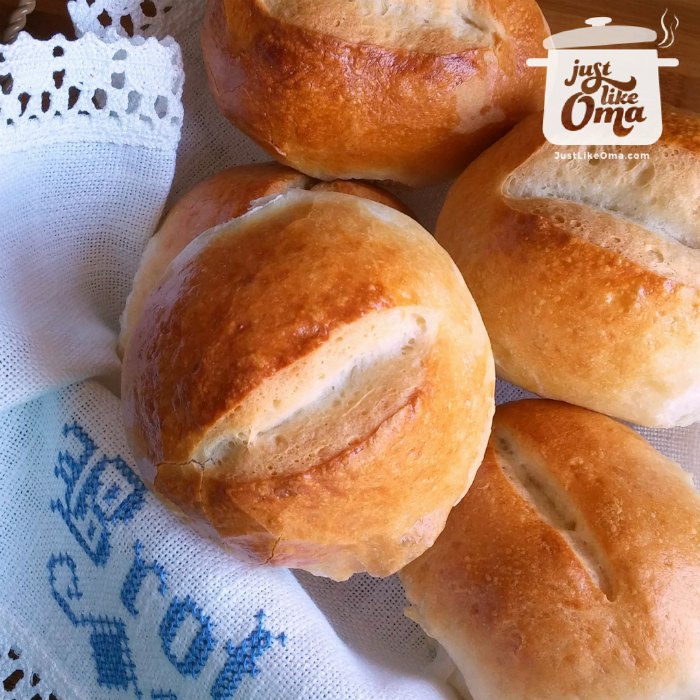
Looking for a German bread rolls recipe that's reminiscent of the Brötchen you had in Germany? Take a look at these. They are just like Oma's! Depending which part of Germany you are from, these are know by various names . Brötchen (a diminutive of Brot meaning bread), Semmel, Schrippe, Rundstück or Weck, Weckle, Weckli, or Wecken. However, they are all know for being WUNDERBAR!
Using an easy bread machine method keeps the time in the kitchen to a bare minimum, while at the same time filling the house with such a fragrance!
I've had my Black and Decker All-In-One Breadmaker for years.
I use it for making breads, of course, but mostly for making dough. It's the easiest way I've found to make yeast doughs for all sorts of baking.
Brötchen and Kuchen. Staples of German baking!
When it's time to replace my current bread machine, I'll be buying another Black and Decker like the one shown here.
Click the photo for more info .
Along with the preprogrammed settings, it's larger, meaning I can make more dough (= more Brötchen!) and larger loaves.
If there's one thing that's missed by almost everyone who has been in Germany and the one recipe that's always requested, it's this one. And, I've made it really easy by using my bread maker. Just 15 minutes prep time and ready in 3 hours. WUNDERBAR! Do check the IMPORTANT notices below the recipe before you start.
Oma's Brötchen
German Bread Rolls Recipe вќ¤пёЏ
- 1Вј cups lukewarm water
- 2 egg whites
- 1 tsp salt
- 1ВЅ tsp sugar
- 1 Tbsp soft butter
- 3ВЅ cups all-purpose flour (more may be needed)
- 1 Tbsp yeast (active dry)
For the egg wash:
- Put all dough ingredients into Bread Maker. (Follow manufacturer's recommended order.)
- Set Bread Maker on to "dough" setting. This will take about 1ВЅ hours.
- NOTE: after the first few minutes of the machine kneading the dough, check that the dough isn't sticking to the sides of the bread maker and has formed a 'ball'. If the dough is sticking, add a tablespoon of flour, let it knead and gradually add more if needed. The dough should come together without sticking to the pan. See the IMPORTANT note below the recipe.
- When dough is ready, remove it from Bread Maker. Place dough on counter that's lightly dusted with flour and gently fold it several times.
- Form into a roll, about 12 - 16 inches long and then cut into 12 sections.
- Form each piece into a ball and place onto 2 lightly greased baking sheets. Cover and let rise until double in volume, about 45 minutes.
- About 15 minutes before baking, preheat oven to 425В° F. Place an empty baking sheet on bottom rack.
- When oven is hot, gently brush rolls with egg wash ( mixing 1 egg white with 2 Tbsp milk). Cut a fairly deep slash in top of each roll with very sharp knife.
- Place 1 cup of ice cubes on the hot baking sheet in oven just before placing baking sheets with rolls into oven.
- Bake for about 18 - 20 minutes or until tops are nicely browned. Be careful when removing the rolls from the oven . there may be steam that escapes when you open door (from ice cubes).
- Remove to rack and let cool for about ВЅ hour before serving.
- Makes 12.

IMPORTANT #1 :
Check the consistency of the dough after the first few minutes after the bread machine has mixed everything together and has started kneading it. Depending on the consistency, one may need to add more flour, a tablespoon at a time, until the dough no longer sticks to the sides.
The amount of flour depends on things like the brand, humidity, altitude, etc. Whenever I use the bread machine for any baking or dough-making, I always check every time. Sometimes extra is needed. Other times not.
IMPORTANT #2 :
Once the dough has risen and you are putting it onto the counter, make sure the counter is floured. If you've made artisan bread, you'll almost recognize the consistency of this rolls dough is similar. It's very, very soft . it almost flows!
In order to make it into rolls, you'll need to keep your extra flour handy. You do want to be gentle with the dough. Fold it over gently several times. Gently pull it into a long roll and cut into 12 sections.
Now, on a floured counter, gently form each section into a ball. You'll need to keep your hands floured. Only add as little flour as you can to keep the ball from sticking. To get a smooth outside, place the ball of dough into one hand. With the other, pull the outside edge and pinch into the middle. It's also possible to do it directly on the counter. Take a look at the video on this page. The dough for the German rolls is a much softer dough than shown in the video, but the method is still the same for forming them.
This takes a bit of practice, but, my, my. It is worth it!
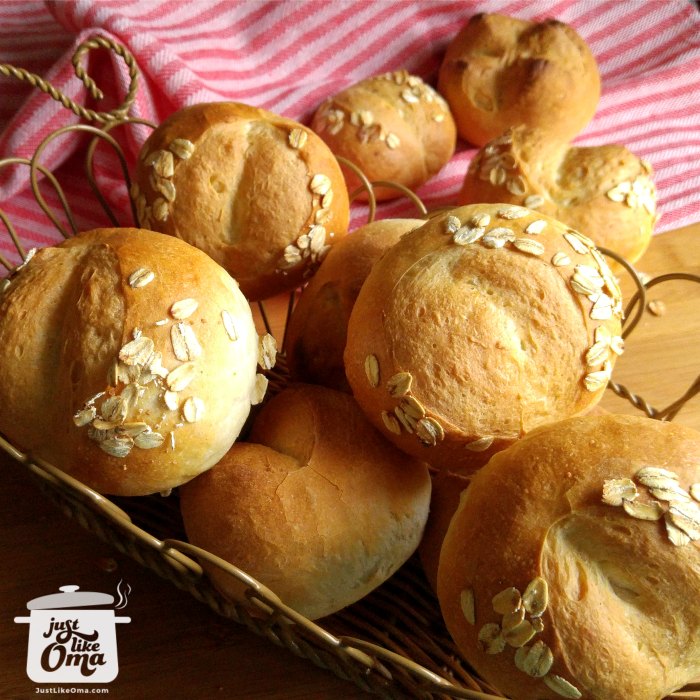
Really! It's that simple. That's why it's part of these German recipes. It's that good! REALLY! These have become hubby's favorite Brötchen . he especially loves them with butter and jam for dessert!
Are these Brötchen identical to the ones you can get in Germany?
No, they are not identical. But they are great alternatives that taste so similar to us that we're happy. Why are they different? Part of the problem is that it is difficult to get the same kind of flour as is available in Germany. And the other part of the problem is that making real Brötchen is very time consuming.
So, is it possible to make real Brötchen outside of Germany? Yes, with the right ingredients and time. However, for me, I wanted something that is so similar to what we had in Germany that is also practical to make at home. And quick. And wunderbar. And, this recipe is it.
If we're wanting a bit more 'crunch' . I make my Artisan Bread . that's so yummy too!
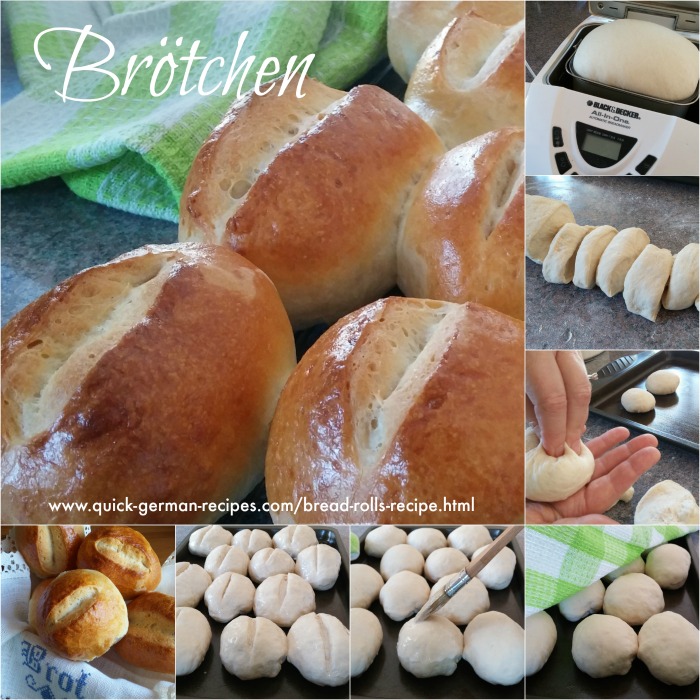
Leftover Brotchen?
These taste best fresh the same day they are made. If you recall the ones you had in Germany, they didn't keep well till the next day, in fact later the same day, they no longer had that nice crisp crust. That's why they were always bought fresh every morning for breakfast!
However, if you have leftovers, you can spray them lightly with water and place in a 425В° F oven for a few minutes and the crust will be crispy again. Or, you can freeze them and then, once thawed, spray lightly with water and place in a 425В° F oven for a few minutes as well.
That way, you can enjoy these even if they were not baked the same day. :)
More German Bread Recipes
Want nutritional information for a recipe? Copy and paste the ingredient list and the number of servings into Calorie Count. It will give you an approximate calculation.


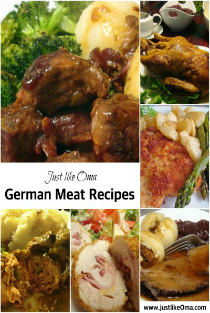
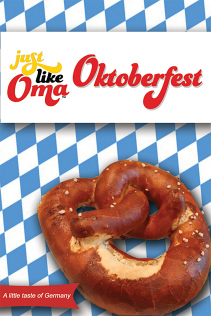
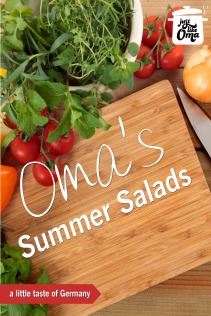


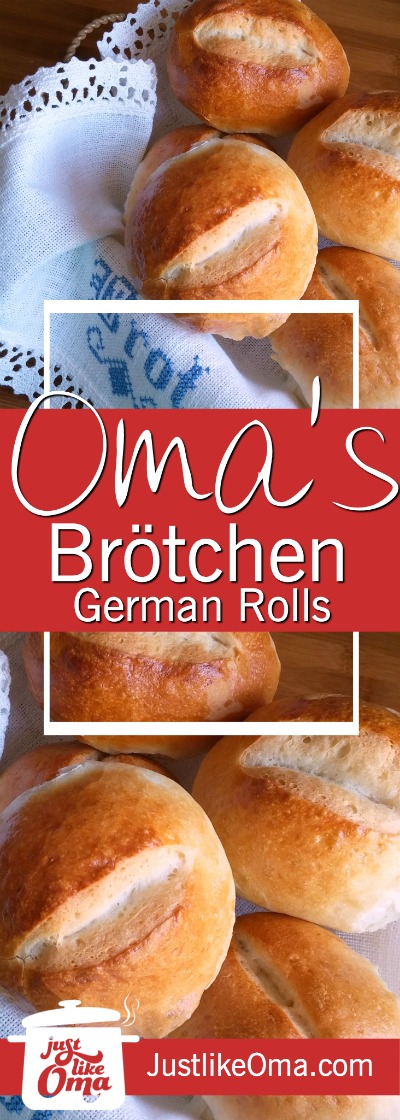
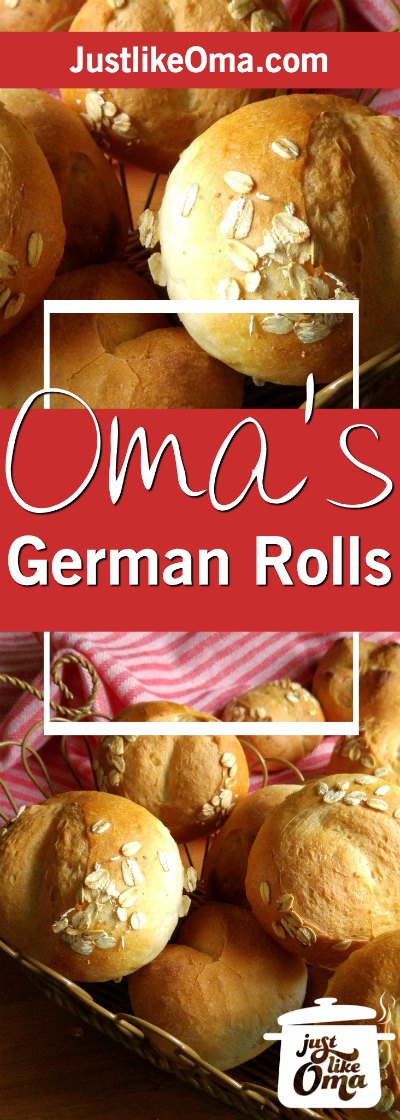
Words to the Wise
"The wise don't make a show of their knowledge, but fools broadcast their foolishness."
Proverbs 12:23 (NLT)
Oma's Brötchen
German Bread Rolls Recipe вќ¤пёЏ





 Looking for a German bread rolls recipe that's reminiscent of the Brötchen you had in Germany? Take a look at these. They are just like Oma's!

Ingredients: 3 egg whites, 3½ cups flour, 1 Tbsp butter, 1 Tbsp yeast, 11½ tsp sugar, 2 Tbsp milk,
For the full recipe, scroll up .

FYI: If you make a purchase via a link on the page, I may earn a small commission it, at no cost to you. That's how I keep the recipes FREE FOR YOU. Thanks for your support! Disclosure policy here .

Recent Articles

Quark Stollen
Nov 21, 17 09:23 AM
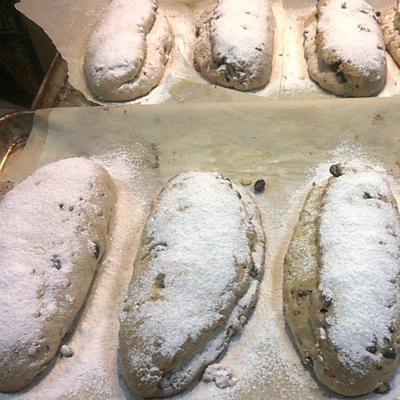
I fell in love with Stollen first time i tasted it in 1985 where I spent two months in Germany to learn German language in Blaubeuren in the months December
вњ”пёЏ German Hazelnut Cookies made just like Oma вќ¤пёЏ
Nov 18, 17 08:29 AM
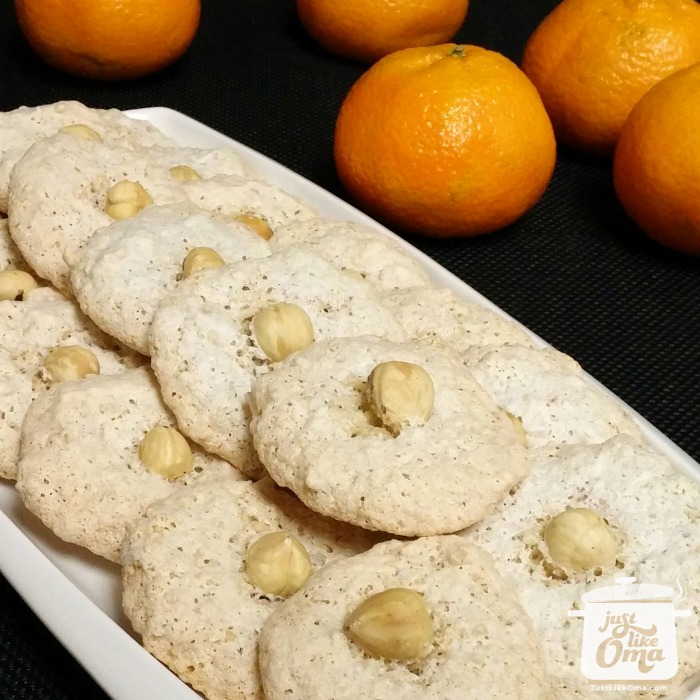
German Christmas Hazelnut Cookies are such a treat. So easy to make. So deliciously Christmas-y! These will remind you of your Oma's kitchen.
Potato Dumplings (Kartoffelknödel)
Nov 16, 17 10:58 PM
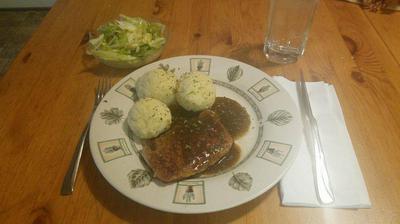
This is my favorite recipe for potato dumplings that give you light and fluffy dumplings. Makes 8 dumplings Ingredients: 2 lbs potatoes (I prefer yellow
Making Bread

Enjoyed your visit? Please click Like above..
Kalorientabelle Brötchen, Semmeln
An dieser Stelle findest du die Kalorientabelle Brötchen, Semmeln und die entsprechenden Kalorien in Brötchen und Semmeln. Die Bezeichnung Brötchen wird vor allem in Nord-und Mitteldeutschland für Kleingebäcke unterschiedlicher Art verwendet. In Süddeutschland sind sie eher als Semmeln, Weckle oder Wecker verbreitet. Das Kleingebäck darf nach deutschen Leitsätzen nicht über 250 Gramm wiegen, ein Mindestgewicht ist gesetzlich jedoch nicht vorgeschrieben. Alle Backwaren der Nährwerttabelle Brötchen, Semmeln wie Vollkornbrötchen, Mehrkornbrötchen, Weizenbrötchen, Laugenbrötchen oder Körnerbrötchen haben ein sehr kurzes Haltbarkeitsdatum und bleiben nur wenige Stunden richtig knusprig und frisch. Gefertigt werden die Backwaren auch im Handwerk meist mit Unterstützung von Maschinen wie einer Brötchenpresse. Nur noch sehr selten wird das Gepäck mit der Hand geformt. In der Industrie erfolgt die Produktion ohnehin vollautomatisch. Die Brötchen und Semmeln der Kalorientabelle werden zu 90 Prozent aus Mehl gefertigt, Salz, Wasser, Hefe und ein Backmittel bilden überdies Bestandteil der Rohmasse. Meist wird dem Teig der Brötchen und Semmeln Fett hinzugefügt oder Roggen und Samen beigemischt. Vorwiegend kommt bei der Zubereitung von Produkten der Kalorientabelle Brötchen, Semmeln Weichweizenmehl zum Einsatz.
Mit unserem Ernährungstagebuch kannst Du Deine Kalorien online zählen und protokollieren. Komplett kostenlos!
Berechne Deinen Kalorienverbrauch bei der Ausübung verschiedener Sportarten und Hausarbeiten.
Ballasstoffe nur in Vollkornprodukten
Die Kalorientabelle Brötchen, Semmeln soll einen Überblick über die Nährwerte in Brötchen und Semmeln geben. Es lässt sich zudem gleich auf einen Blick erkennen, wie viel Kalorien in Brötchen und Semmeln tatsächlich versteckt sind. Der Anteil an Fett ist zwar eher gering, dementgegen besitzen Brötchen und Semmeln viele Kohlenhydrate. Diese sind grundsätzlich gute Energielieferanten für unseren Körper. Sind die Backwaren aus Weißmehl gefertigt, werden dem Organismus jedoch über Brötchen und Semmeln nur Kalorien zugeführt. Nur beim Verzehr von aus Roggenmehl oder Vollkornmehl hergestelltem Kleingebäck werden dem Körper nicht nur Zucker, sondern auch Mineralstoffe, Stärke, Vitamine und Ballaststoffe zugeführt. Darüber hinaus enthalten Brötchen und Semmel Eiweiß, das dem Körper ebenfalls Energie liefert.
Selber backen lohnt sich
Wenn man hinsichtlich der Inhaltsstoffe auf Nummer sicher gehen will, sollte man am besten selbst in die Rolle des Bäckers schlüpfen. Leider mischen nur noch wenige kleine Bäckereien ihr Mehl selbst an. Meist werden die Backwaren aus Großbäckereien bezogen, die fertige Mehlmischungen verwenden. Backt man selbst, geht der Teig meist nicht so stark auf, da nicht so viel Trieb- und Hilfsmittel wie in der industriellen Fertigung benutzt werden. Ein großer Vorteil bei der eigenen Herstellung ist natürlich der individuelle und frische Geschmack, da man den Teig nach Belieben immer wieder unterschiedlich verfeinern kann. Auch ist man bestens über die in Brötchen und Semmeln enthaltenen Nährwerte informiert.
Kurze Lagerzeit
Man muss sich darüber im Klaren sein, dass derartiges Frischgebäck sehr schnell altert. Je größer jedoch der Roggenanteil, desto länger kann es gelagert werden. Grundsätzlich bleiben Brötchen und Semmeln der Nährwerttabelle aber nur wenige Stunden richtig frisch und knusprig. Das liegt vor allem daran, dass die geschmacksbestimmende Kruste zu Anfang trocken ist und dann Feuchtigkeit aus der Umgebung aufnimmt. Dadurch nimmt die ganze Ware eine weiche und pappige Konsistenz an. Generell empfiehlt es sich, das Gebäck kühl und trocken zu lagern. Noch warme Backware sollte nie in der Verpackung verbleiben, da die ausdampfende Feuchtigkeit sonst auf die Kruste übergeht.
Du willst eine größere Auswahl? Hier findest du eine ausführliche Kalorientabelle Brötchen, Semmeln mit vielen hundert Einträgen.
Ähnliche Kalorientabellen
Nachfolgend findest Du die Kalorientabelle Brot, Brötchen, Backwaren mit den enthaltenen Kalorien. Brot, Brötchen, Backwaren sind in Deutschland sehr beliebt, kein Land der Welt hält.
Kalorientabelle Brot
An dieser Stelle findest du die Kalorientabelle Brot und die dazugehörigen Kalorien. Brot zählt in Deutschland zu den wichtigsten Grundnahrungsmitteln. Im Laufe von mehr als.
Kaiser Brötchen / Kaiser rolls
The Kaiser roll is also called a Vienna roll or Semmel or Kaisersemmel or kaiserbroodje in Dutch
Dutch version coming soon…
Think sweet smelling soft crumb and thin crispy crust, these rolls are on the other side of the artisan bread baking spectrum. But they deserve their place in your warm, fresh-out-of-the-oven home-baked bread repertoire!
Everybody, in Holland for sure, knows these rolls with the characteristic star shape, made by hand or with a stamp. When you buy these rolls they usually do not seem to have much weight or taste. But, as so often with home baking, making them yourself changes everything. You use the right (and probably much less) ingredients, you give it time and suddenly it is very rewarding to make these adorable little rolls. They go with any meal, are great at a traditional family dinner or a summer picknick or just with a bowl of homemade soup.
Lets get baking!
Ingredients for the Kaiser rolls
500 g German 550 /French type 55 / all purpose flour
7 g instant yeast
1 tsp / 7 g honey
Making this dough is pretty straightforward, combining, kneading, resting, shaping and final proofing, but for a good baking result it is important to use the right (quality) ingredients and also keep your dough under optimum conditions during the whole making and baking process. If you want to learn more please check out these tips:
–Tips on the use of your oven for splendid results
Note: We use European flour which absorbs a few % less water than American type flour. People using American type flour should add 4-9 ml water to the dough.
In a mixing bowl of a standing mixer with a dough hook attached, combine the flour with the salt. Add the yeast, water, milk and honey and knead for 7 minutes. If you are kneading by hand it will take a bit longer, between 12 and 15 minutes depending on your kneading. You are aiming for an elastic dough that is ever so slightly sticky. Leave to rest for 2 hours in a bowl, sprayed with some oil, and cover with clingfilm.
Now divide the dough into 12 equal pieces of just about 70 g each. Shape the dough pieces into balls, place them on the baking sheet or tray you are also going to use to put them in the oven, cover (we do this with a floured piece of clingfilm) and let them relax for 10 minutes.
Preheat your oven to 220ºC / 430ºF. The preparation time from this point until the bread actually goes into the oven is about 1 hour.
Continue by pressing the kaiser roll stamp into each ball of dough like you see in the picture to get the 5 pointed star pattern. Cover them and leave to proof for 50 minutes to 1 hour. When you think the rolls have risen enough, use your floured finger to carefully make a very small dent in the dough. If the dent remains, the bread is ready to bake, if the indentation disappears, the dough needs a little bit more time.
You can also decorate your rolls with sesame seeds or poppy seeds before they go into the oven. Spray with some water and sprinkle on the seeds.
Try to create some steam in your oven by putting a small metal baking tray on your oven floor when you preheat the oven and pour in half a cup of hot water immediately after putting the bread in the oven. Release some steam by setting your oven door ajar 5 minutes before the bread is ready. If you are going to create steam with a baking tray, you maybe also want to turn your oven temperature a bit higher, because you are going to lose some heat in the process.
Bake in the preheated oven for 20 minutes and leave to cool on a rack.
Leave a Reply Cancel reply
Gerry Oakley says
Finally a recipe in grams …not cups and spoons ..noticed some recipes have butter but no butter here .. going to try this one ..
Weekend Bakers says
Big believers in scales, also for the home baker!
We hope the recipe turns out well. If you want to enrich this dough with some butter, we would suggest adding around 20 grams, but no more. Hope you like it as is!
You have one use different measurements for liquids ml or liter but not g. Gramm is for weight only 😜
Weekend Bakers says
Bakers actually do weigh their liquids, also water, to be accurate every time and get a consistent baking result. Measuring is less precise.
Daniela Bauernfeind says
Can I have this recipes, in german please.
Weekend Bakers says
Our German translation skills are not that good, but maybe google translate can help you.
Luke Smith says
This recipe for kaiser rolls looks amazing, and I especially love your advice to sprinkle them with poppy seeds before they go in the oven! I have always loved fresh baked rolls, but I don’t have a lot of time these days to make them. Reading about them right now though made me determined to have some…
I would like to do this over two days. Can I do the first resting of 2 hours in the fridge overnight? Do you guys have any idea if this would this be equivalent to 12 or 24 hours at 3C?
Thanks for a great website.
Weekend Bakers says
Hi, you will be fine. Let the dough develop for 1 hour before putting it in the fridge to give it a head start.
Lynn Macdonald says
Greetings! I want to make these for a lunch soon, but we don’t have the Kaiser Stamp. Would these be ok to just roll and score the top? Also, after mixing the flour, water etc., how would it affect the final product if I had to leave it in the cold room overnight?
Weekend Bakers says
Hi Lynn, no problem using a knife, you end up with great tasting white rolls! About the cold room; I do not really understand what you mean by that! Sorry!
Dennis Shinn says
I live in Zirndorf Germany for 16 years and still today love my German rolls,i thank you so much for the recipe for the Kaiser,but as you know there are others.I would like know how to make there one other i like don’t know the name but they were shaped like a football and had a spit down the top,but were very good as well.thanks for any help on these rolls a photo would help thanks your weekend baker..
Weekend Bakers says
Hello Dennis, thanks you for comment. We do not know this type of roll. We will have a look, but we only have one German bread book and this roll is not in this book. When we find something we will post a recipe.
Hi, I think he means the Deutsche Schnit brotchen.
Randy Jones says
possibly meant Rogen brötchen
Randy Jones says
possibly meant Laugenbroetchen
I tried to follow the recipe exactly but I don’t have a standing mixer and I have been kneading the dough by hand for about an hour to no avail. It is still super sticky and not very elastic at all. Quite frustrating. Any advice?
Tina C Millard says
Stop! People have made bread for centuries without stand mixers; it can be done. You do not need (pun intended) to knead the dough for an hour. It sounds to me, from what you say, as if you should be adding flour by the tablespoon until the dough is not so sticky. A little sticky is fine; so sticky you can’t get it off your hands is too wet. Fifteen minutes kneading should be adequate. If at all possible, find someone locally to show you once what the texture of unbaked bread dough should look and feel like. You won’t forget and will know in future what to aim for. You can do it.
Weekend Bakers says
Very good advice Tina, thank you for your comment!
Thank you guys for another great recipe! Tried it for the first time today and they came out looking great, popped them straight from the cooling rack into the freezer and will be tasting them next thing in the morning. Would it be possible to use wholewheat flower instead of the all purpose flower, or would you have to make changes in measurements?
Keep up the great work!
Weekend Bakers says
Hi Rob, first of all with whole wheat flour the rolls will be much less fluffy. You will need more water as all the fibres in the whole wheat flour do absorb a lot of water. So add about 30g to 40g of water to be get up to about 68% of hydration. Happy baking!
Randy Jones says
Tried your recipe and they turned out beautifully. Very light on the inside and just as you described tender slightly crunchy crust. Served ’em up with soft boiled eggs and Langnese honey and Nutella. My wife was raised in Nurnberg area and she was “One Happy Girl”, have tried several recipes trying to get it right and this one was the best.
Thanks for posting.
Weekend Bakers says
Always nice to get such wonderful feedback. Sounds exactly right! We are guessing you are going to bake some more in the near future…
Happy Brötchen Baking!
Gerdina Schwab says
I just tasted one of these wonderful rolls that I baked today. It is the kaiser roll recipe I have been looking for a very long time. They will become a staple in my house and will be made weekly. The only thing I will change is the size since we use them as sandwich rolls. So the recipe will make 6 instead of 12. BTW I am a Dutch woman living in the US and your tips for adding just a little more water makes perfect sense and worked very well.
I can’t wait to try the other artisan bread recipes you have here.
Weekend Bakers says
How wonderful to hear you made the kaiser rolls in America and you like them so much! Great idea to make 6 bigger ones, that will be no problem indeed, (maybe a few minutes more oven time).
If and when you make some of our other recipes, would love to hear about your results too.
Weet iemand of je ze voor het afbakken ook kunt invriezen of heel even afbakken en dan de vriezer in.
Does anyone know if you can put them into the freezer before baking, perhaps baking them shortly?
Weekend Bakers says
Ja dat kan. Je kunt het beste tot ongeveer 2/3 van de tijd afbakken, afkoelen en dan snel invriezen.
Afbakken kan dan in 7 tot 10 minuten (beetje afhankelijk van oven).
Great project: fast, easy and satisfying. My only diversion from the recipe was that I added a tad butter. I read in a number of German recipes that they add butter, so I did too. Without the mold, I folded the dough to get a shape that remotely resembles the iconic form.
Weekend Bakers says
Nothing wrong with adding a bit of butter I think!
Greetings and happy weekend baking,
your recipes is good
Sylvia Vervest says
Made these today with the French 55, they are delicious (I sneaked one before they cooled off) thanks for the recipe. Btw is the Zandhaas Tarwebloem ok to use to make them.
Claartje in UK says
Another perfect recipe from WKB! Since I don’t have a stamp (yet) I ‘knotted’ the dough and the result is stunning!! Thanks again, especially on behalf of my OH who thinks this is my best homemade bread I ever baked ….. (Why bother doing multi day sourdough projects, using different heritage flours, etc.)
Weekend Bakers says
I know what you mean. My parents and my neighbors just returning from a German Holiday were more than pleased with the Kaiser rolls. It is just nice to mix it up ones in a while. ‘Verandering van spijs doet eten’!
The knotting gave a fine result too I must say!
Have a great (baking) weekend,
PS: You can see Claartjes Kaiser rolls and lovely Baguette Boule on our ‘Your Loaves’ page: www.weekendbakery.com/your-loafs/
Net deze broodjes gemaakt. Zien er prachtig uit. Nog even tip voor als het deeg te plakkerig is om te stempelen. Duw de stempel voor elk broodje even in wat bloem. Werkt perfect.
Weekend Bakers says
Dank je voor deze zeer handige toevoeging en geniet van de broodjes!

Комментариев нет:
Отправить комментарий